Types Of Hearing Aids
A hearing aid helps the ear to pick up sound, amplifies it and sends it into the ear canal. A hearing aid consists of a microphone that picks up sound waves and converts them into electrical signal, an amplifier, a loudspeaker (or receiver) that converts the amplified signals into sound and an ear mould or plastic tube that sends the sound into the ear canal.
Hearing aids have a battery door where the battery is put in and you have the option of a volume control and/or a telecoil switch. A telecoil switch allows you to use your hearing aid on the telephone. Some hearing aids also have a program button where you can switch between different settings.
What Are The Types Of Hearing Aids?
There are many styles of hearing aids. The most common styles are listed below:
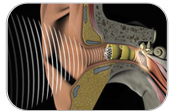 Invisible-In-The Canal (IIC) Extended Wear
Invisible-In-The Canal (IIC) Extended Wear
Lyric the first completely invisible, extended wear hearing aid. Phonak breakthrough hearing aid requires no handling at all and remains in your ear 24/7. There are no batteries to change, no maintenance is needed and no daily insertion or removal is required.
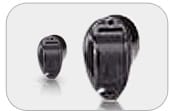 Invisible-In-Canal (IIC)
Invisible-In-Canal (IIC)
Starkey’s SoundLens, newest custom fit style is truly 100% invisible when worn. The instrument sits in the second bend of the ear and comes complete with Starkey’s industry-leading technology.
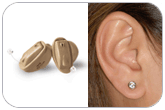 Completely-In-Canal (CIC)
Completely-In-Canal (CIC)
Fits completely in the ear canal and is virtually invisible.
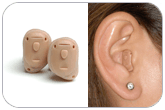 In-The-Canal (ITC)
In-The-Canal (ITC)
These hearing instruments fit into the ear canal and are slightly larger than CIC hearing aids and have option of a volume control on the faceplate.
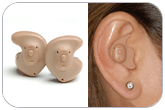 In-The-Ear (ITE)
In-The-Ear (ITE)
These Instruments are custom-made to fit within your entire ear. While being more visible, this style offers a larger battery size, and larger volume wheel for ease of operation.
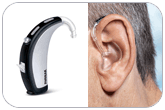 Behind-The-Ear (BTE)
Behind-The-Ear (BTE)
These hearing instruments rests behind the ear while a clear plastic tube then directs amplified sound into an earmold inside the ear canal. They are the most reliable and most powerful of hearing instruments. Also available in a mini and micro size for improved cosmetics.
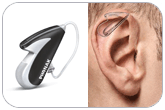 Receiver-In-Canal (RIC) or Canal-Receiver-Technology (CRT)
Receiver-In-Canal (RIC) or Canal-Receiver-Technology (CRT)
This very small and feather light hearing instrument rests behind the ear. The ergonomic design, combined with extremely thin tubing, results in a uniquely satisfying cosmetic solution. The receiver (speaker) resides within the ear canal to deliver superior sound clarity.
What is the Best Hearing Aid for Me?
Choosing the right hearing aid for your condition can be quite challenging, and you’ll often need assistance from a specialist to help you decide. Hearing aids come in different styles and have multiple features, making a perfect pair for someone else not suitable for you. To help pick the best option, ask yourself the following:
Are Your Activities Limited?
BTE devices are the most suitable options if you are homebound or have cognitive impairments. You may also consider assistive listening devices like special smoke detectors, amplified telephones, bed-shaker alarms, or doorbells that flash.
Do You Have Problems with Dexterity?
Dexterity issues like difficulty grasping small items and losing feeling in your fingertips can make it more difficult to handle smaller hearing aids. Instead, consider low-profile BTE and ITE devices because they are larger and easier to handle. Hearing aids that have automated features instead of tiny buttons are also preferable.
Do You Currently Wear Hearing Aids?
You may already have hearing aids but want to update them. It’s always best to start with the style and design of your current device. You will always find a similar style with newer, more modern features. You should also have your hearing tested before fitting your new hearing aids.
What Is Your Hearing Ability?
Knowing the kind of hearing loss you have helps you determine the best hearing aids. If your hearing loss is in the high frequencies, you may prefer the open-fit RITE hearing aid styles because they allow you to hear natural low-frequency sounds.
Power aids are great for severe-to-profound hearing loss. These may include ITC hearing aids, BTE hearing aids, or low-profile ITE hearing aids. They provide the most powerful amplification.
What to Consider When Researching Types of Hearing Aids
When delving into the world of hearing aids, the variety and advancements in technology can be impressive and overwhelming. To ensure you make an informed decision that enhances your quality of life, here are key factors to consider during your research:
- Consult a Hearing Professional: Begin your journey by speaking with a hearing care specialist. Their expertise is invaluable in understanding your specific hearing loss and guiding you toward the most suitable hearing aids.
- Seek Solutions for Background Noise: In many environments, background noise can be a significant challenge. Look for hearing aids with advanced features that focus on speech while reducing unwanted background sounds, ensuring clearer conversations.
- Feedback Noise Reduction: Feedback noise, such as whistling sounds from hearing aids, can be distracting. Explore options that include technology specifically designed to minimize this type of interference, providing a more comfortable listening experience.
- 360-Degree Sound Experience: Some hearing aids offer a 360-degree sound experience, capturing the full spectrum of sound in your environment. This feature can dramatically improve spatial awareness and the natural feel of sound.
- Understand Your Personal Hearing Needs: Everyone’s hearing loss is unique. Reflect on your daily activities, lifestyle, and where you most often find hearing challenging. These considerations will help identify the features most beneficial to you.
Our Experts Can Recommend the Best Hearing Aids for You
Schedule an appointment with our hearing loss specialists today! Our team provides extensive hearing tests at our hearing clinic to determine the most effective treatment options for your condition, including recommending the best hearing aids.
Contact us today for treatment or book a hearing test to check your hearing condition.

